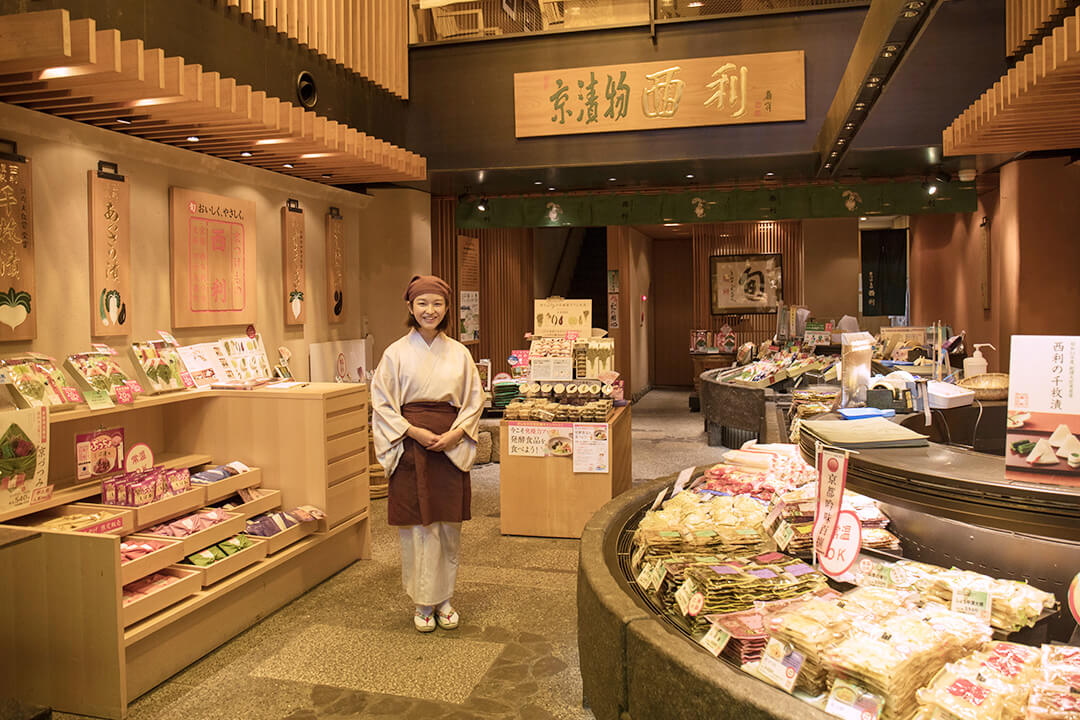Search results for "Souvenir"
38件Please note that business hours and regular holidays may have changed.
Touan
The Touan Nishiki-koji Store is located in Nishiki Market, the "kitchen of Kyoto," affectionately known as "Nishiki" to the people of Kyoto. The store is a place where you can easily find Kyo-yaki and Kiyomizu-yaki fine ceramic pottery handmade by skilled craftspeople.
- Tableware
- household goods

Nishiri
“Our goal is to bring health and happiness to our customers by respecting the Japanese food culture under the theme of ‘seasonal, delicious, and mild,’” they say. “In addition to traditional pickled products such as senmaizuke sliced turnip and suguki turnip, we also offer the ‘Kyo-no-assari-zuke (light Kyoto pickels)’ series, which brings out the flavor of vegetables with less salt than usual, and the ‘Nishiri Labre’ series, which utilizes the lactic acid bacteria Lactobacillus brevis KB290, abbreviated as ‘Labre,’ discovered in suguki-turnip.”
- pickles
- restaurant

TerakoyaHonpo
This sembei (rice crackers) and dango (rice dumplings) shop is located just inside the west entrance of Nishiki Market. They stick to the traditional method of making sembei. Domestic sticky rice is steamed and pounded into rice cakes, which are then baked with a soy-sauce-based sauce made with a secret recipe. The most popular products are mochi rice crackers made from 100% domestic sticky rice, nure-okaki (rice crackers with a chewy inside), and dango made of sticky rice.
- Japanese sweets

Pulau Deco
The name of the shop reflects its main concept of creating your own island paradise in your home. “Pulau” means “island” in Indonesian. Many of the tableware and other items are imported from Bali. Japanese ceramics such as Kiyomizu-yaki and Arita-yaki are also featured.
- Tableware
- household goods

Ochanoko saisai
Ochanoko Saisai is a specialty store that sells chili pepper seasoning, which is a must for those who love spicy food. In particular, the “Maiko Han Hee Hee (literally, ‘Maiko scream’)” series is captivating hot spicy food lovers. Made with domestically produced habanero chili peppers, it is characterized by a hot spiciness that lingers in the mouth. In addition, there are many other specialty products such as yuzu shichimi (shichimi seven spices with yuzu citrus), black shichimi, and “Kyo-Rayu (chili oil) Furikake,” a delicious topping that makes eating rice irresistible.
- Japanese sweets
- seasoning

Yuuzen
Chopsticks can be the perfect souvenir of Kyoto. It is fun to choose from among about 800 varieties with expert advice at this shop. In addition to chopsticks, the shop also has chopstick rests, Kiyomizu-yaki and Mino-yaki tableware, and Ishizuka glassware. They offer a service of engraving names, dates, and messages on chopsticks free of charge. These chopsticks will become a memorable gift.
- chopsticks

Kidoairaku
The husband, Yosuke, works with the potter's wheel and his wife, Chie, paints the pottery. The couple creates their pottery together and sells it at this shop. The kiln is located in the storehouse at back of the traditional Kyoto-style townhouse, known to be as long and narrow as “an eel’s bed.” The potter's wheel is located inside the shop, and if you happen to visit at the right timing, you can see the potters at work. Tasting and sales of sake by Tanzan Sake Brewery are also available at the store.
- Tableware
- sake, whisky, beer

Fuka
The history of the main shop of Fuka, which manufactures and sells nama-fu (Nama-fu are raw gluten cakes used for cooking), is long, with records showing that it was supplying nama-fu to the Imperial Palace in the Keio era (1865-1868) at the end of the Edo period. The Nishiki store opened around 1980 as a retail store. Production is done at the main store, which takes pride in making fu by hand without relying on machines. Their fish-shaped cakes with sweet bean fillings “Taiyaki fu manju” are now popular as a new type of fu manju dessert.
- soy food
- Japanese sweets

Nishiki Murasaki
“The roots of this restaurant lie in an oshiruko (sweet bean soup) and noodle store started by my father around 1945. I am committed to delivering the best-tasting food by cherishing the spirit of dedication that was taught to me by my father,” says the owner of Nishiki Murasaki. Drawing on his own experience working at a confectionery store, he now focuses on peanuts, Kyoto sweets, and old-fashioned Japanese sweets. “Every morning we purchase the highest grade peanuts from Enshu (Hamamatsu City, Shizuoka Prefecture), which are freshly roasted, and only enough for that day's sales.”
- Japanese sweets

Sawawa
You can tell by the color of the shop’s curtains and sign that this store has something to do with green tea. It specializes in matcha green tea sweets, especially on sweets using matcha from Uji. The first floor sells a variety of matcha sweets, and the second floor is a café, which offers a menu that includes warabimochi (bracken starch jelly), parfaits, and anmitsu (a sweet bean paste desert with agar-agar jelly, etc.). They use spring-harvested tea leaves and the grinding is done in a stone mortar right in the store for you to see.
- Japanese sweets
- western style sweets
- restaurant




